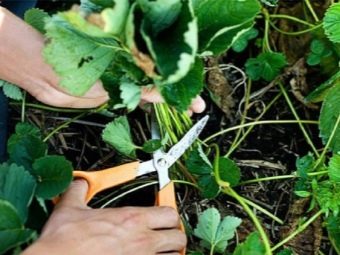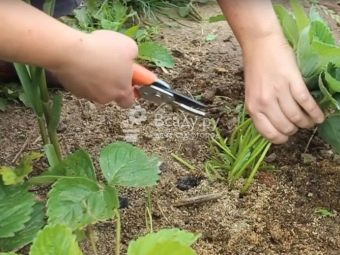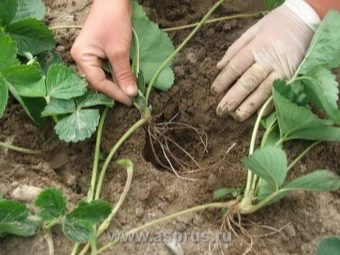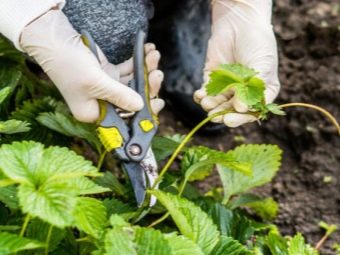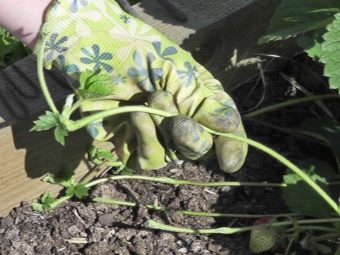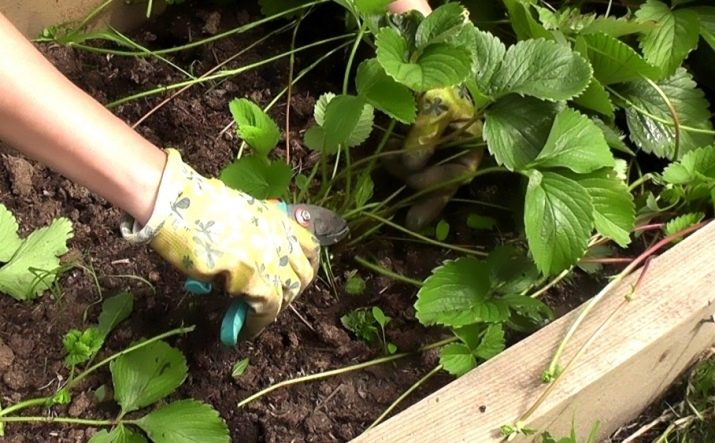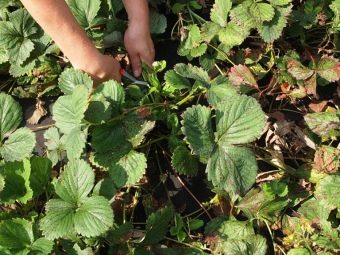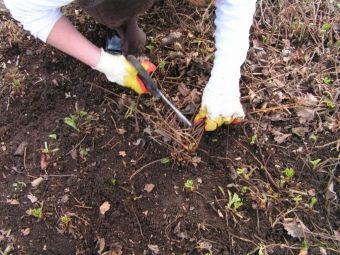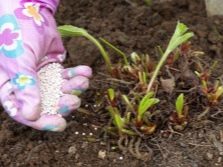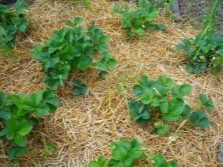When and how to cut the strawberries after harvest?
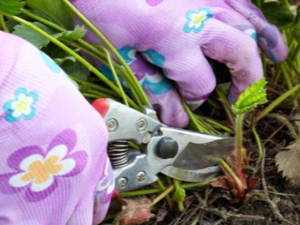
It's no secret that strawberries are one of the most capricious cultures.Her harvest can be spoiled not only by poor soil and bad weather conditions, but also by the wrong care of the gardener. Care of the culture is not limited to watering, weeding, as well as elementary feeding. In addition to all the above, which is considered traditional in the cultivation of most plants, garden strawberries still need timely and proper pruning of the whiskers and the bush itself.
Why do you need pruning?
Experienced gardeners note that the high yield of strawberries largely depends on the autumn pruning of the bush. It is with her that the quality and quantity of the next year's harvest is tied, because the procedure performed according to all requirements allows the plant to prepare for winter “hibernation”, retaining the necessary amount of energy until spring, when it can perk up with greater force.
If you cut the strawberries after harvest, in the new season you can get 40 percent more berries than otherwise. So how is pruning related to the harvest next year? The fact is that after the work done (we are talking about fruiting), the plant begins a period of rest. But not strawberries.
Having rested slightly from fruiting, it forms foliage with new force. If you live in the southern regions, it is possible to get a second harvest. In other regions, it is impossible to speak of re-yields due to the climatic conditions, so it would be better to save the plant's energy until next year, which is done through post-harvest pruning.
Next year, without pruning, you can get lush tops instead of high yields.
Fundamental rules
So, consider what constitutes the autumn pruning of a strawberry bush.
- After the complete cessation of fruiting, which is checked by the absence of color buds on the bush, it is necessary to remove the old mulch from the garden bed (if any). Then remove the weeds with roots. As soon as the bed is completely clean, it is necessary to examine the bushes from all sides for signs of disease or pests. Most likely, that wasps, ants, if they were on your strawberry, by the fall you must have got rid of them. As for the nematode, which is leaf (living on leaflets) and soil (living in the earth), things are much more complicated here.
- First, they lay the larvae in the desired habitat (bush or soil).
- Secondly, they calmly hibernate until spring, when it will be possible to start eating fresh culture again. The task of the gardener - notice them and destroy. And it can be done by removing from the garden and destroying damaged bushes. The bush, on which the nematode settled, looks slightly underdeveloped, it is noticeably smaller than the others, the leaves on it, having dried, do not have time to finish. And in general, it has a dryish-yellowish appearance.
- As soon as noticeably vulnerable bushes are removed, you can proceed directly to pruning. We cut off the young, newly emerging sheets. Do not forget about the necessary removal of a mustache. Well, if you need additional planting material, it is quite acceptable to sprinkle a strong mustache on the ground from a well-fruited bush. In order not to lose a bush with a high yield over time, during cutting it is desirable to tie any bright ribbon onto the stem.
- Remove all the mustache correctly, as they say "at the root", that is, to the ground. Working with a mustache, pay attention to the old leaves: if they have any defects (yellowness, dryness), then they must be cut off, because the flaws are the first sign of the disease.
- It is better not to remove the leaves on newly planted young bushes (which are less than a year old), since this greatly injures the already not very strong plant.
- Conducting the above measures, the main thing is not to overdo it with the removal of foliage, since excessiveness can lead to a painful state of culture.The cold and rainy days coming in the fall will be a cause that intensifies the adverse effects. Thus, it is not necessary to postpone the procedure, waiting for the approach of autumn.
Terms and methods
In addition to the trimming itself, it is equally important to maintain the necessary time. Since today there are different varieties of strawberries (early ripening, medium ripeness and late), then it is quite difficult to establish any definite dates, and, moreover, climatic conditions in many ways affect the ripening of berries. In this regard, some gardeners prefer to perform the procedure closer to the fall, while others insist that it can be carried out in the summer, almost immediately after fruiting.
Considering the influence of climate on strawberries after fruiting, it is necessary to note the following seasonal features.
- If you postpone the procedure until autumn, it is not excluded that by the onset of cold weather the plant will not have time to recover. This will significantly complicate the wintering culture. Crop immediately after harvesting nothing, except for the wounded leaves. But for the most part, we are not interested in them, but in young, newly emerging foliage, which will immediately begin to attract the attention of pests. This is one of the reasons why it is recommended to do pruning in the summer, without delay until autumn.
- Usually, after a complete harvest, the countdown is about 2 weeks and the bushes are pruned. Most often this occurs in July.
- If we talk about methods of pruning, then experienced gardeners have their own methods. Some, so that the plant does not suffer, shears cut off absolutely all sheets at a height of about eight centimeters. Others remove everything almost at the root. Someone prefers absolute pruning selective: young foliage and part of the old. The choice of pruning method depends directly on the severity of winter in the region.
- In severe winters, good insulation is required. Most likely, dry branches are not enough here, but you will have to resort to using warm rags, which can break a rather tall bush. If the winters are not harsh, then you should not hurt the crop too much, you can get along with selective pruning, and in the winter to cover the strawberries with dry grass and branches.
- But the most optimal pruning, according to experts, is when the garden bed is covered completely with cellophane film, on which small holes are made for each bush. The strawberries are cut completely so that a small bundle protrudes from the hole, which is not deformed even by heavy rags, and the film will retain heat throughout the entire time.
- In no case and in any way you can not perform the procedure manually, as it is likely to disrupt the root system of capricious strawberries.
- There are cases when gardeners cut mulch from cut leaves, but such an approach can hurt the crop, because the foliage (especially with flaws) can be affected by something (insects, diseases), which will go to healthy shrubs.
Aftercare
After the treatment is carried out properly, care must be taken of the injured bushes and of the soil, which must first be loosened, which will enrich it with oxygen. We do this not only around the bush, but throughout the garden, including the aisle. It is recommended to pay attention to the humidity. If the ground is wet enough, then it is not necessary to water the crop, and if it is dry, then water the strawberries as usual.
Immediately it is necessary to take care of feeding. If there are no obvious signs of a disease, then it is better to purchase combined agrochemicals in specialized stores, where there is a full range of necessary elements (fluorine, potassium, nitrogen, and much more). In the post-harvest period, the use of such chemicals is perfectly acceptable, since the berries are harvested, which eliminates harm to human health. A substance divorced in the right proportions cannot harm a plant.
But do not forget that their use is extremely undesirable from the moment of formation of the ovaries, as it leads to accumulation of nitrates on strawberries.
Enriching the soil, it is recommended to take care of mulch beds, which will help keep the heat and moisture necessary for the roots in the ground. The ideal option for mulch will be peat, which is irrigated with a solution of ammonia. Its fragrance scares off many insects: ants, wasps, as well as a relatively elusive nematode.
Along with the nematode, in the summer period, strawberries are often affected by a spider mite, due to which the sheets take on a crumpled appearance, resembling corrugated paper. In principle, the strong smell of ammonia will scare away the insect, but after harvesting, nothing prevents you from using a specialized drug that eliminates the direct cause of the plant's disease.
There is absolutely no guarantee that the strawberries processed in July according to all the rules will not pick up the rot, which has different forms of manifestation. Therefore, closer to September, it is recommended to treat the bed with an aqueous solution based on green paint. Zelenka, like nothing else, prevents the occurrence of this disease, in addition, its action is aimed at strengthening the plant immunity.
In order to prevent the preparation of a solution at the rate of one drop per liter of water, the resulting concentrate irrigates the bed. At the first signs of the disease we make a stronger solution (two drops per liter of water), irrigate 2-3 times a week until the culture is completely cured. We warm the beds for the winter and wait for the onset of spring.
How and when to cut the strawberries, see the next video.

